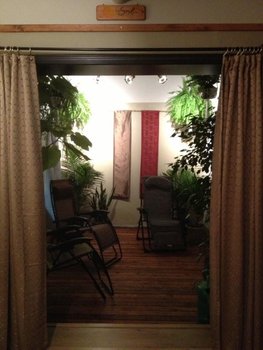
by Gord Grant PhD, RAc
This is the next article in a series about ATP’s “turning points”. I have described the beginning of our story – go here to read the series.
Our original dilemma was presented in the choice between offering clients a dedicated one-on-one service or a more cost-efficient multiple client model, in which people are treated simultaneously in separate rooms in quick succession. In these dedicated private treatment options, we discovered that being more present or available to provide a more thorough and dynamic investigation and treatment when needed, not only on the first visit, but also in subsequent follow-ups for more complex situations, was usually well worth it for both client and practitioner! The outcomes were better and it has been really worth the extra cost for many clients.

But when is this treatment model not required? Private, dedicated treatments are often prohibitively expensive for many to continue beyond a few sessions — even if a person is progressing and responding well to therapy! This of course, became the seed of our offering the choice of community acupuncture, which is now another integral pillar of our services. It represents the most affordable, transparent expression of a multiple patient treatment model. Today, I will explore more deeply some themes and insights regarding the treatment cost dilemma from the client perspective. Two big themes come foreward: private insurance for those who have it, and the urgency of a health problem, for those who do not.
People tend to get treatments as long as insurance pays: We noticed that many people came to see us only as long as they had insurance, even if they really benefited from acupuncture and obviously needed more to resolve an ongoing issue. Most private insurance for acupuncture runs out at about $500 per year, which translates to about 6-8 private treatments, depending on the service. Usually, regardless of improvement or what was evident for optimal progress, clients cease treatments when their insurance runs out. A personal investment toward healthcare treatments is often not given priority. I think this may be due to a historical Canadian mindset and expectation toward “free” healthcare services.
People who pay out of pocket are less likely to continue services past a crisis: The majority of clients who have come to us and paid out of pocket for our one-on-one services, because they had no insurance, tended to come only in crisis in which they were not able to sleep, or could not work or function due to back pain, headaches, or some other life-suspending affliction. Usually, they had already exhausted the vast repertoire of our free medical system. This had not worked, or at least had not solved the problem for good, and the problem had come back with a vengeance! These people are often at the end of their rope, they are desperate, and we try to help them get out of their crisis. Like the medical system, in these cases we usually can only be successful in bringing temporary relief initially. But what we do differently is that we do it without drugs and with a focus on lifestyle change, helping our client’s develop insight and full responsibility for their problem. However, clients often will not continue treatments after the crisis is resolved, even though addressing core issues may prevent the situation from reoccurring. It is difficult for many to justify the extended personal cost when they do not have insurance. For those who DO take on the challenge of this opportunity, it often becomes a veritable “Turning Point”, not only in healing the problem, but also in improving their whole health and quality of life. This is why we have learned to take extra time with each client, assuming each could be ready to make this critical shift.
One-on-one private sessions, therapeutically, are not always necessary.
On the flip side of the coin, we have noticed that sometimes the extra assessment and attention during treatments are not necessary. Especially later on in a treatment series where there has been systematic progress in the extent of the client’s condition, and no major changes were happening to the nature of his or her condition. Subsequently the treatment protocol did not have to change dramatically and less practitioner time was needed. A dilemma arose because even if we could predict when extra time was not necessary, and we were able to double book these types of clients together in separate rooms, we recognized the extra cost of the private room may also not be necessary. This is especially so when only the arms, legs, and face are the points being needled – in these cases, clothes need not be removed to access the back or other hard-to-get places, and we theoretically could treat people more efficiently in a shared room while they relax in chairs (ie community acupuncture). We realized that sometimes people falling into this above group were unnecessarily burdened by the higher price of private sessions, and discontinued treatment, even though they believed acupuncture was helping them.
So we decided to introduce the idea of community acupuncture in the summer of 2012. It enabled us to offer a transparent choice: on one hand, the dramatically more affordable alternative of community acupuncture, or on the other, if needed or desired, the extra practitioner attention toward a more rigorous, albeit more costly, private treatment. Community acupuncture has allowed our clients to experiment a little. They find out what worked best for them, all things considered, like cost, treatment efficacy, the great feeling of being in a group, or the privacy and thoroughness of a dedicated session. Now on a typical private insurance plan, with community acupuncture, clients are able to afford coming weekly for treatments, if this is what they need.
Who uses our community acupuncture service anyhow?
The clients we see who most use and benefit from community acupuncture come for the following reasons:
- Needs for frequent treatments over an extended time: this is driven by a need for low treatment costs in order to extend insurance or when paying out of pocket. It’s a make or break decision for many.
- A proven and efficient community protocol works. When a protocol being used is on the arms and legs (and sometimes face) there is an option for community acupuncture. This proof can come from either the client’s own experience as discovered in private treatments or in community treatments by trying our recommended protocols.
- A desire to be “in community”, in a beautiful and supportive environment, getting treatment at the same time with a friend or just anonymously with others.
The people who come to community acupuncture most commonly come for the following specific conditions:
- Stress reduction or a restorative/relaxation focus. This is about prevention by optimizing health and wellbeing. The best relaxation points that calm the autonomic nervous systems fight-or-flight response are on the arms and legs. Recent research shows that people with anxiety or depression benefit from regular acupuncture as much as from counselling.
- Chronic pain sufferers; headaches/migraines, and conditions that are directly accessible on arms and legs. Many do find relief though on neck and back pain, from classic, general pain points that are located on hands and feet.
- Fertility treatments: Women and men come due to difficulties conceiving, or before, during, and after medical interventions like IVF. Fertility protocol points are usually accessible to us when clients are relaxing in a lounge chair.
- Labour Inductions: Pregnant woman come in before delivering their baby to help induce labour, decrease the probability of interventions, and help labour go more smoothly. The best induction points are on arms and legs.
- Fatigue, PMS, or digestion, immunity, and metabolic/hormone imbalances. Many general imbalances of metabolism are influenced indirectly by acupuncture through a relaxation response of the autonomic nervous system, and the best points for this are on arms and legs. We promote what is already working in you!
We encourage a client-centred model of therapy, where your preferences and therapeutic experience of outcomes are important to you gaining confidence and responsibility in your approach to healing and health. Regardless of your reasons for seeking therapy or your preferences for a private or a community setting, we want what works best for you!
Next article on the ATP story, I focus on the history and background of community acupuncture, and explore the roots of community Acupuncture in China, North America, and ATP!




